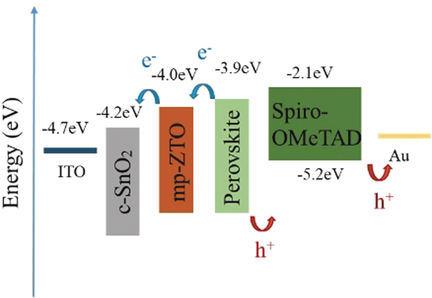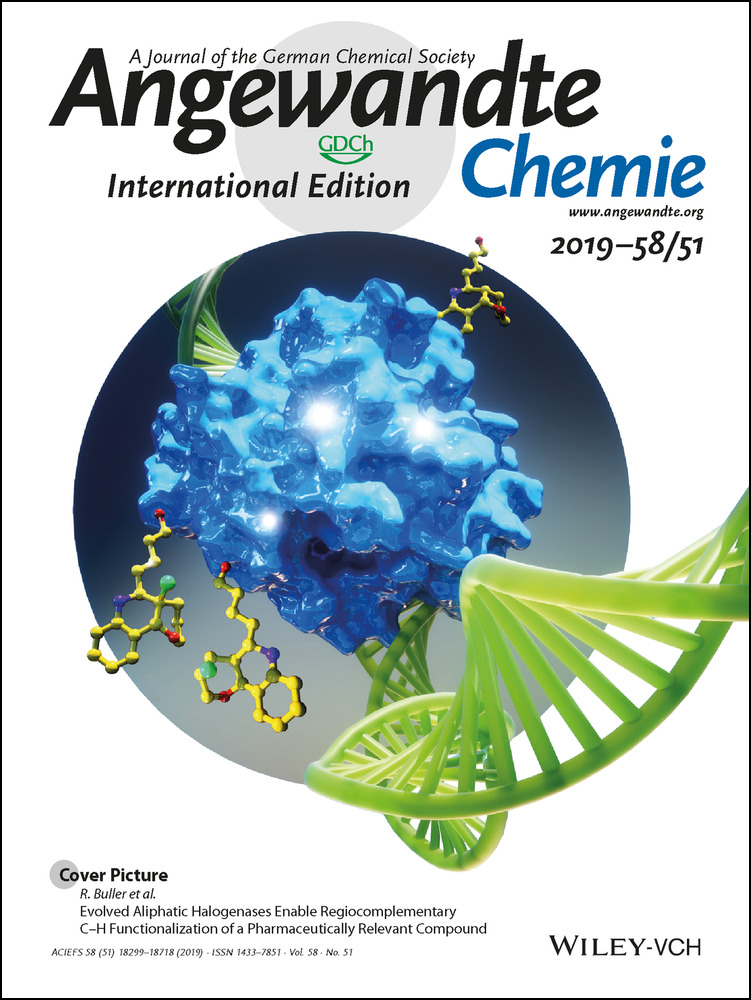Enhanced Lifetime and Photostability with Low-Temperature Mesoporous ZnTiO3/Compact SnO2 Electrodes in Perovskite Solar Cells
Fengwan Guo
Beijing National Laboratory for Molecular Sciences, State Key Laboratory for Structural Chemistry of Unstable and Stable Species College of Chemistry and Molecular Engineering, Peking University, Beijing, 100871 China
Search for more papers by this authorXiangyu Sun
State Key Laboratory of Information Photonics and Optical Communications School of Science, Beijing University of Posts and Telecommunications, Beijing, 100876 P. R. China
Search for more papers by this authorBing Liu
Hubei Collaborative Innovation Center for Advanced Organochemical Materials, Ministry-of-Education Key Laboratory for the Synthesis and Applications of Organic Functional Molecules, Hubei University, Wuhan, 430062 P. R. China
Search for more papers by this authorZijiang Yang
Beijing National Laboratory for Molecular Sciences, State Key Laboratory for Structural Chemistry of Unstable and Stable Species College of Chemistry and Molecular Engineering, Peking University, Beijing, 100871 China
Search for more papers by this authorCorresponding Author
Jing Wei
Experimental Center of Advanced Materials, School of Materials Science & Engineering, Beijing Key Laboratory of Construction-Tailorable Advanced Functional Materials and Green Applications, School of Materials Science & Engineering, Beijing Institute of Technology, Beijing, 10081 China
Search for more papers by this authorCorresponding Author
Prof. Dongsheng Xu
Beijing National Laboratory for Molecular Sciences, State Key Laboratory for Structural Chemistry of Unstable and Stable Species College of Chemistry and Molecular Engineering, Peking University, Beijing, 100871 China
Search for more papers by this authorFengwan Guo
Beijing National Laboratory for Molecular Sciences, State Key Laboratory for Structural Chemistry of Unstable and Stable Species College of Chemistry and Molecular Engineering, Peking University, Beijing, 100871 China
Search for more papers by this authorXiangyu Sun
State Key Laboratory of Information Photonics and Optical Communications School of Science, Beijing University of Posts and Telecommunications, Beijing, 100876 P. R. China
Search for more papers by this authorBing Liu
Hubei Collaborative Innovation Center for Advanced Organochemical Materials, Ministry-of-Education Key Laboratory for the Synthesis and Applications of Organic Functional Molecules, Hubei University, Wuhan, 430062 P. R. China
Search for more papers by this authorZijiang Yang
Beijing National Laboratory for Molecular Sciences, State Key Laboratory for Structural Chemistry of Unstable and Stable Species College of Chemistry and Molecular Engineering, Peking University, Beijing, 100871 China
Search for more papers by this authorCorresponding Author
Jing Wei
Experimental Center of Advanced Materials, School of Materials Science & Engineering, Beijing Key Laboratory of Construction-Tailorable Advanced Functional Materials and Green Applications, School of Materials Science & Engineering, Beijing Institute of Technology, Beijing, 10081 China
Search for more papers by this authorCorresponding Author
Prof. Dongsheng Xu
Beijing National Laboratory for Molecular Sciences, State Key Laboratory for Structural Chemistry of Unstable and Stable Species College of Chemistry and Molecular Engineering, Peking University, Beijing, 100871 China
Search for more papers by this authorGraphical Abstract
Low-temperature-processed, UV-inert ZnTiO3 as a mesoporous layer was introduced in SnO2-based planar perovskite solar cells. The application of ZnTiO3 modified the interface of SnO2/perovskite, and significantly improve the UV stability and lifetime of devices. The low-temperature mesoporous structure expands the choice for transmission layer and electrode materials.
Abstract
Perovskite solar cells (PSCs) with power conversion efficiencies (PCEs) of 25 % mainly have SnO2 or TiO2 as electron-transporting layers (ETLs). Now, zinc titanate (ZnTiO3, ZTO) is proposed as mesoporous ETLs owing to its weak photo-effect, excellent carrier extraction, and transfer properties. Uniform mesoporous films were obtained by spinning coating the ZTO ink and annealed below 150 °C. Photovoltaic devices based on Cs0.05FA0.81MA0.14PbI2.55Br0.45 perovskite sandwiched between SnO2-mesorporous ZTO electrode and Spiro-OMeTAD layer achieved the PCE of 20.5 %. The PSCs retained more than 95 % of their original efficiency after 100 days lifetime test without being encapsulated. Additionally, the PSCs retained over 95 % of the initial performance when subjected at the maximum power point voltage for 120 h under AM 1.5 G illumination (100 mW cm−2), demonstrating superior working stability. The application of ZTO provides a better choice for ETLs of PSCs.
Supporting Information
As a service to our authors and readers, this journal provides supporting information supplied by the authors. Such materials are peer reviewed and may be re-organized for online delivery, but are not copy-edited or typeset. Technical support issues arising from supporting information (other than missing files) should be addressed to the authors.
| Filename | Description |
|---|---|
| anie201911796-sup-0001-misc_information.pdf489.3 KB | Supplementary |
Please note: The publisher is not responsible for the content or functionality of any supporting information supplied by the authors. Any queries (other than missing content) should be directed to the corresponding author for the article.
References
- 1Best Research-Cell Efficiency Chart 2019, https://www.nrel.gov/pv/cell-efficiency.html.
- 2Oxford PV perovskite solar cell achieves 28 % efficiency 2018, https://www.oxfordpv.com/news/oxford-pv-perovskite-solar-cell-achieves-28-efficiency.
- 3N. Li, Z. Zhu, Q. Dong, J. Li, Z. Yang, C. Chueh, A. Jen, L. Wang, Adv. Mater. Interfaces 2017, 4, 1700598.
- 4E. Ercan, J. Chen, P. Tsai, J. Lam, S. Huang, C. Chueh, W. Chen, Adv. Electron. Mater. 2017, 3, 1700344.
- 5M. Abdi-Jalebi, Z. Andaji-Garmaroudi, S. Cacovich, C. Stavrakas, B. Philippe, J. M. Richter, M. Alsari, E. P. Booker, E. M. Hutter, A. J. Pearson, S. Lilliu, T. J. Savenije, H. Rensmo, G. Divitini, C. Ducati, R. H. Friend, S. D. Stranks, Nature 2018, 555, 497–501.
- 6H. Hsu, C. Chen, J. Chang, Y. Yu, Y. Shen, Nanoscale 2014, 6, 10281–10288.
- 7Z. Wang, Q. Lin, F. P. Chmiel, N. Sakai, L. M. Herz, H. J. Snaith, Nat. Energy 2017, 2, 17135.
- 8M. Saliba, J. Correa-Baena, M. Grätzel, A. Abate, Angew. Chem. Int. Ed. 2018, 57, 2554–2569; Angew. Chem. 2018, 130, 2582–2598.
- 9N. J. Jeon, H. Na, E. H. Jung, T. Yang, Y. Lee, G. Kim, H. Shin, S. Seok, J. Lee, J. Seo, Nat. Energy 2018, 3, 682–689.
- 10Z. Liu, K. Deng, J. Hu, L. Li, Angew. Chem. Int. Ed. 2019, 58, 11497–11504; Angew. Chem. 2019, 131, 11621–11628.
- 11Y. Wang, J. Wan, J. Ding, J. Hu, D. Wang, Angew. Chem. Int. Ed. 2019, 58, 9414–9418; Angew. Chem. 2019, 131, 9514–9518.
- 12P. Zhang, J. Wu, T. Zhang, Y. Wang, D. Liu, H. Chen, L. Ji, C. Liu, W. Ahmad, Z. D. Chen, S. Li, Adv. Mater. 2018, 30, 1703737.
- 13W. Ke, G. Fang, Q. Liu, L. Xiong, P. Qin, H. Tao, J. Wang, H. Lei, B. Li, J. Wan, G. Yang, Y. Yan, J. Am. Chem. Soc. 2015, 137, 6730–6733.
- 14J. P. C. Baena, L. Steier, W. Tress, M. Saliba, S. Neutzner, T. Matsui, F. Giordano, T. J. Jacobsson, A. R. S. Kandada, S. M. Zakeeruddin, A. Petrozza, A. Abate, M. K. Nazeeruddin, M. Grätzel, A. Hagfeldt, Energy Environ. Sci. 2015, 8, 2928–2934.
- 15Q. Jiang, L. Zhang, H. Wang, X. Yang, J. Meng, H. Liu, Z. Yin, J. Wu, X. Zhang, J. You, Nat. Energy 2017, 2, 16177.
- 16J. Wei, F. Guo, X. Wang, K. Xu, M. Lei, Y. Liang, Y. Zhao, D. Xu, Adv. Mater. 2018, 30, 1805153.
- 17Y. Rong, Y. Hu, A. Mei, H. Tan, M. I. Saidaminov, S. Seok, M. D. McGehee, E. H. Sargent, H. Han, Science 2018, 361, eaat 8235.
- 18Y. Hu, Z. Zhang, A. Mei, Y. Jiang, X. Hou, Q. Wang, K. Du, Y. Rong, Y. Zhou, G. Xu, H. Han, Adv. Mater. 2018, 30, 1705786.
- 19J. Burschka, N. Pellet, S. Moon, R. Humphry-Baker, P. Gao, M. K. Nazeeruddin, M. Grätzel, Nature 2013, 499, 316–319.
- 20A. Mei, X. Li, L. Liu, Z. Ku, T. Liu, Y. Rong, M. Xu, M. Hu, J. Chen, Y. Yang, M. Grätzel, H. Han, Science 2014, 345, 295–298.
- 21Y. Rong, L. Liu, A. Mei, X. Li, H. Han, Adv. Energy Mater. 2015, 5, 1501066.
- 22A. Capasso, F. Matteocci, L. Najafi, M. Prato, J. Buha, L. Cinà, V. Pellegrini, A. D. Carlo, F. Bonaccorso, Adv. Energy Mater. 2016, 6, 1600920.
- 23W. Yang, B. Park, E. Jung, N. Jeon, Y. Kim, D. Lee, S. Shin, J. Seo, E. Kim, J. Noh, S. Seok, Science 2017, 356, 1376–1379.
- 24N. Ahn, K. Kwak, M. Jang, H. Yoon, B. Lee, J. Lee, P. V. Pikhitsa, J. Byun, M. Choi, Nat. Commun. 2016, 7, 13422.
- 25H. Tan, A. Jain, O. Voznyy, X. Lan, F. P. G. Arquer, J. Z. Fan, R. Quintero-Bermudez, M. Yuan, B. Zhang, Y. Zhao, F. Fan, P. Li, L. Quan, Y. Zhao, Z. Lu, Z. Yang, S. Hoogland, E. H. Sargent, Science 2017, 355, 722–726.
- 26M. Saliba, T. Matsui, K. Domanski, J. Seo, A. Ummadisingu, S. M. Zakeeruddin, J. Correa-Baena, W. R. Tress, A. Abate, A. Hagfeldt, M. Grätzel, Science 2016, 354, 206–209.
- 27X. Li, D. Bi, C. Yi, J. Décoppet, J. Luo, S. M. Zakeeruddin, A. Hagfeldt, M. Grätzel, Science 2016, 353, 58–62.
- 28X. Zheng, B. Chen, J. Dai, Y. Fang, Y. Bai, Y. Lin, H. Wei, X. Zeng, J. Huang, Nat. Energy 2017, 2, 17102.
- 29H. Tan, F. Che, M. Wei, Y. Zhao, M. I. Saidaminov, P. Todorović, D. Broberg, G. Walters, F. Tan, T. Zhuang, B. Sun, Z. Liang, H. Yuan, E. Fron, J. Kim, Z. Yang, O. Voznyy, M. Asta, E. H. Sargent, Nat. Commun. 2018, 9, 3100.
- 30H. Zhou, Q. Chen, G. Li, S. Luo, T. Song, H. Duan, Z. Hong, J. You, Y. Liu, Y. Yang, Science 2014, 345, 542–546.
- 31E. Jung, N. Jeon, E. Park, C. Moon, T. Shin, T. Yang, J. Noh, J. Seo, Nature 2019, 567, 511–515.
- 32G. Grancini, C. Roldán-Carmona, I. Zimmermann, E. Mosconi, X. Lee, D. Martineau, S. Narbey, F. Oswald, F. Angelis, M. Grätzel, M. K. Nazeeruddin, Nat. Commun. 2017, 8, 15684.
- 33D. Yang, R. Yang, S. Priya, S. Liu, Angew. Chem. Int. Ed. 2019, 58, 4466–4483; Angew. Chem. 2019, 131, 4512–4530.
- 34T. Leijtens, G. E. Eperon, S. Pathak, A. Abate, M. M. Lee, H. J. Snaith, Nat. Commun. 2013, 4, 2885.
- 35S. Shin, E. Yeom, W. Yang, S. Hur, M. Kim, J. Im, J. Seo, J. Noh, S. Seok, Science 2017, 356, 167–171.
- 36D. W. de Quilettes, S. M. Vorpahl, S. D. Stranks, H. Nagaoka, G. E. Eperon, M. E. Ziffer, H. J. Snaith, D. S. Ginger, Science 2015, 348, 683–686.
- 37S. K. Pathak, A. Abate, P. Ruckdeschel, B. Roose, K. C. Gödel, Y. Vaynzof, A. Santhala, S. Watanabe, D. J. Hollman, N. Noel, A. Sepe, U. Wiesner, R. Friend, H. J. Snaith, U. Steiner, Adv. Funct. Mater. 2014, 24, 6046–6055.
- 38A. Kogo, M. Ikegami, T. Miyasaka, Chem. Commun. 2016, 52, 8119–8122.
- 39C. M. Pelicano, H. Yanagi, J. Mater. Chem. C 2017, 5, 8059–8070.
- 40K. Wang, Y. Shi, L. Gao, R. Chi, K. Shi, B. Guo, L. Zhao, T. Ma, Nano Energy 2017, 31, 424–431.
- 41E. H. Anaraki, A. Kermanpur, L. Steier, K. Domanski, T. Matsui, W. Tress, M. Saliba, A. Abate, M. Grätzel, A. Hagfeldt, J. Correa-Baena, Energy Environ. Sci. 2016, 9, 3128–3134.
- 42D. Yang, R. Yang, K. Wang, C. Wu, X. Zhu, J. Feng, X. Ren, G. Fang, S. Priya, S. Liu, Nat. Commun. 2018, 9, 3239.
- 43Y. Lee, S. Lee, G. Seo, S. Paek, K. Cho, A. J. Huckaba, M. Calizzi, D. Choi, J. Park, D. Lee, H. J. Lee, A. M. Asiri, M. K. Nazeeruddin, Adv. Sci. 2018, 5, 1800130.
- 44W. Tress, J. Correa-Baena, M. Saliba, A. Abate, M. Grätzel, Adv. Energy Mater. 2016, 6, 1600396.
- 45Y. Yuan, J. Huang, Acc. Chem. Res. 2016, 49, 286–293.





